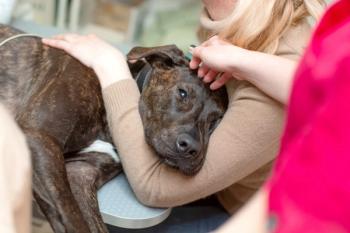
The washered-anchor technique
A refinement of the lateral extracapsular repair.
Abstract
The lateral washered-anchor extracapsular repair (washered-anchor technique) introduces a biomechanically stable modification of traditional extracapsular stifle stabilization. By using a washered screw at the tibial anchor site and either the lateral fabella or a second isometric femoral screw proximally, the construct approximates isometric tension across the stifle’s range of motion while providing robust lateral stability.
Unlike conventional soft tissue–anchored techniques, the washered-anchor approach preserves the medial aspect of the stifle, reducing soft tissue morbidity and improving postoperative recovery. This article reviews the rationale, surgical technique, and supporting biomechanical evidence based on published isometric mapping and extracapsular stabilization (ECS) studies. This approach provides a cost-effective, reproducible stabilization option for cases where tibial plateau leveling osteotomy (TPLO) or tibial tuberosity advancement (TTA) may be impractical.
Introduction
Cranial cruciate ligament rupture remains one of the most common orthopedic causes of lameness in dogs. Although tibial osteotomy procedures such as TPLO and TTA achieve excellent outcomes, ECS continues to serve as a practical, cost-effective alternative for small- to medium-breed dogs or revision cases.
Traditional ECS techniques, such as the Flo and DeAngelis methods, rely on circumfabellar soft tissue loops, which are nonisometric and produce variable tension and suture elongation during flexion and extension.1,2 This variability contributes to residual laxity and inconsistent outcomes over time.
Advances in stifle biomechanics led to the mapping of quasi-isometric femoral and tibial points that maintain nearly constant interanchor distance through the range of motion.4-6 Building on these findings, the washered-anchor technique merges the familiarity of the lateral extracapsular repair with the mechanical predictability of bony, isometric fixation. The result is a stable, reproducible construct that eliminates cranial drawer while preserving the medial joint capsule.
Surgical technique
Step 1: Approach
A routine lateral parapatellar incision is made. The lateral fascia is reflected caudally to expose the lateral fabella and the caudolateral femoral condyle. Meniscal inspection and any necessary debridement or release are performed before stabilization.
Step 2: Identify isometric points
Experimental work has confirmed that true isometric points do not exist, but quasi-isometric pairs provide minimal distance change during flexion and extension.4-6
- Femoral isometric point: This is identified on the caudal edge of the femoral condyle adjacent to the cranial pole of the lateral fabella.4-6
- Tibial isometric point: This is located just distal and caudal to the insertion of the patellar ligament, immediately caudal to Gerdy tubercle—the prominence at the cranial aspect of the extensor fossa of the long digital extensor tendon—along the caudal edge of the tibial extensor groove.4-7
These landmarks maintain a near-constant distance through flexion, reducing cyclic creep and preventing overconstraint.
Step 3: Implant placement
A washered cortical screw is placed at the tibial isometric point to prevent suture cut-through and distribute load evenly.
The suture line—either monofilament nylon or ultrahigh molecular weight polyethylene, such as LigaFiba or FiberWire—is passed to the proximal anchor, which can be:
- The lateral fabella
- A second washered screw at the femoral isometric point for direct bony anchorage
This configuration reproduces the isometric trajectory demonstrated in biomechanical trials while permitting tension adjustment under direct visualization.
Step 4: Tensioning and closure
Tension is applied until the cranial drawer test is negative and tibial thrust is neutralized. The suture is secured under the washers, maintaining a consistent load without suture deformation. The stifle is closed in routine fashion.
Radiographic Evaluation
Discussion
The anatomical and functional relationship of the cruciate ligaments, as first described by Arnoczky and Marshall, provides essential insight into maintaining normal joint mechanics.3 They demonstrated that the cranial cruciate ligament undergoes predictable reciprocal tightening and loosening patterns through flexion and extension, underscoring the importance of isometric reconstruction.
Recent ex vivo biomechanical studies confirmed that ECS using bone anchors and monofilament nylon can restore near-normal stifle stability when placed at quasi-isometric points demonstrated that such placements limit cranial tibial translation (< 1.4 mm) while avoiding excessive internal rotation, validating the concept of controlled isometry.6
The washered-anchor construct refines this by employing hardware that provides bony fixation rather than soft tissue anchorage, distributes tension evenly across a washer interface, and allows straightforward revision or retensioning if required.
The LigaFiba Iso Toggle guide further supports the precision of bony tunnel placement, noting the reproducibility of these quasi-isometric points in the lateral fabellar region and tibial crest.7 Early clinical outcomes demonstrate excellent postoperative limb function, particularly in small to medium breed dogs where TPLO or TTA may be cost-prohibitive or anatomically unsuitable.
Conclusion
The washered-anchor technique serves as a refinement of lateral ECS grounded in sound biomechanical evidence. By combining isometric anchorage with lateral-only access and load-distributing fixation, it provides enhanced stability, reduced tissue trauma, and a reproducible alternative to traditional fabellar sutures.
As studies continue to validate the use of bone anchors and quasi-isometric point mapping, this hybrid technique offers a promising balance of strength, adjustability, and surgical accessibility.
References
- Flo GL. Modification of the lateral retinacular imbrication technique for stabilizing cruciate ligament injuries. J Am Anim Hosp Assoc. 1975;11(5):570-576.
- DeAngelis M, Lau RE. A lateral retinacular imbrication technique for the surgical correction of anterior cruciate ligament rupture in the dog. J Am Vet Med Assoc. 1970;157(1):79-84.
- Arnoczky SP, Marshall JL. The cruciate ligaments of the canine stifle: an anatomical and functional analysis. Am J Vet Res. 1977;38(11):1807-1814.
- Hulse D, Hyman W, Beale B, Saunders B, Peycke L, Hosgood G. Determination of isometric points for placement of a lateral suture in treatment of the cranial cruciate ligament deficient stifle. Vet Comp Orthop Traumatol. 2010;23(3):163-167. doi:10.3415/VCOT-09-05-0054
- Roe SC, Kue J, Gemma J. Isometry of potential suture attachment sites for the cranial cruciate ligament deficient canine stifle. Vet Comp Orthop Traumatol. 2008;21(3):215-220.
- Hsu WR, Lin CC, Sun CY, Wu CH. Ex vivo biomechanical evaluation of extracapsular stabilization with quasi-isometric points in canine cranial cruciate ligament-deficient stifles. BMC Vet Res. 2023;19(1):93. doi:10.1186/s12917-023-03656-7
- Surgery Guide: LigaFiba Isotoggle. Veterinary Instrumentation. Accessed November 6, 2025. https://www.veterinary-instrumentation.com.au/wp-content/uploads/sites/7/2025/04/Vi-ANZ-Surgery-Guide-LigaFiba-Isotoggle-Issue-1-March-2023.pdf
Newsletter
From exam room tips to practice management insights, get trusted veterinary news delivered straight to your inbox—subscribe to dvm360.




